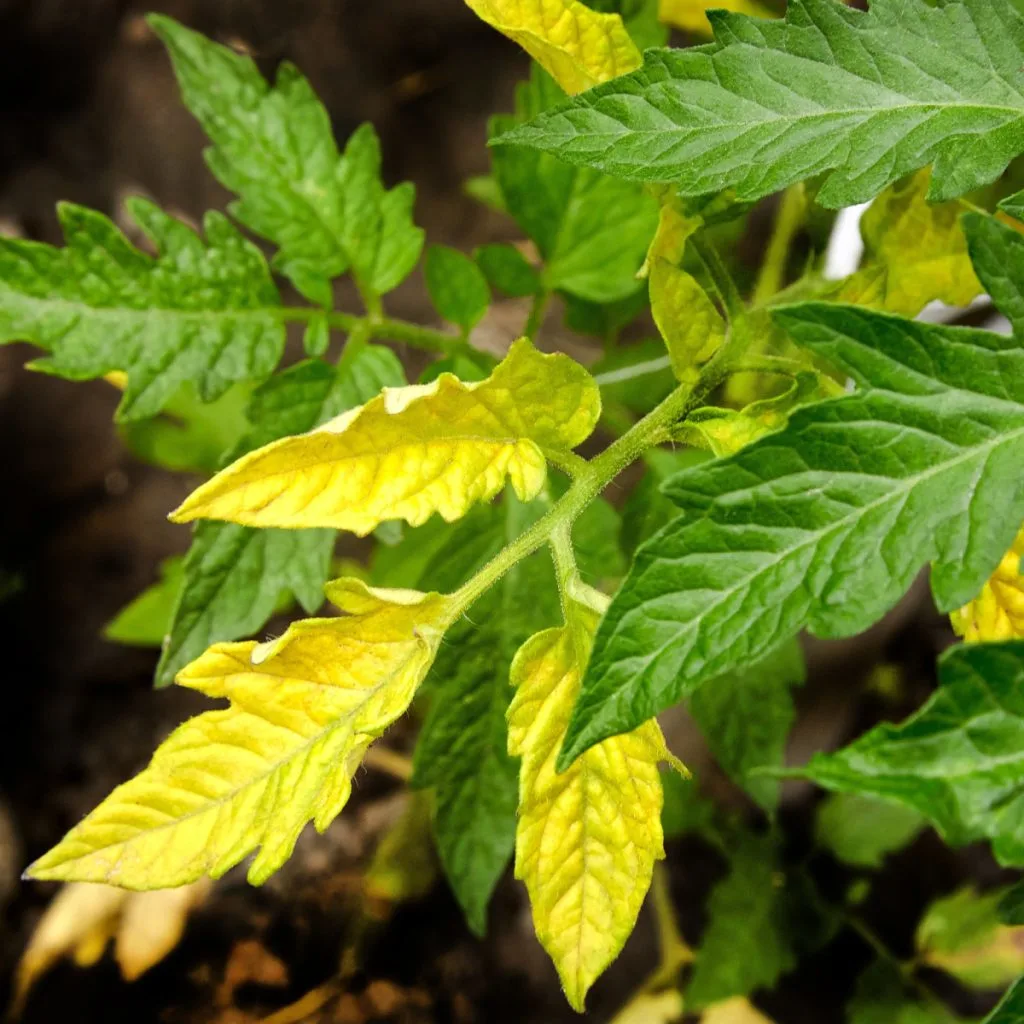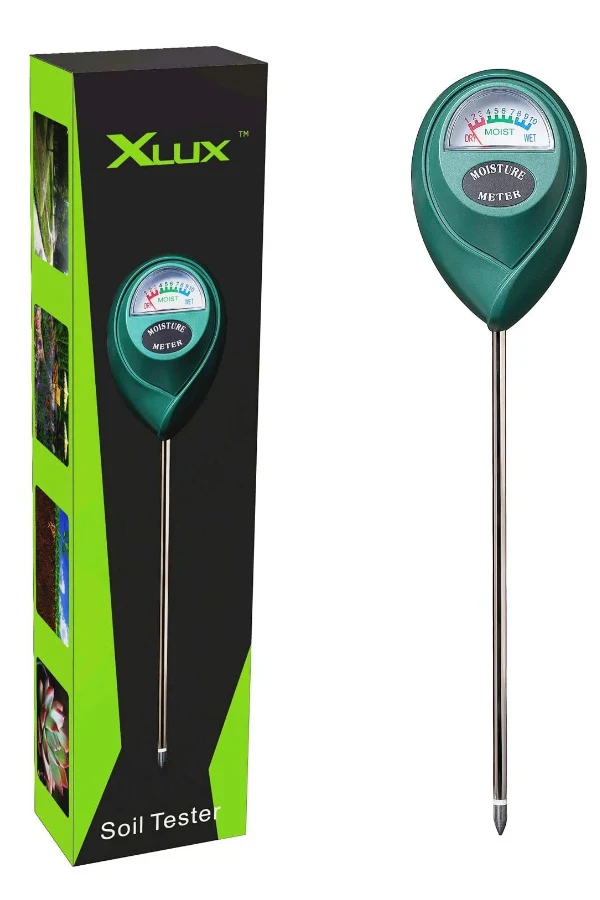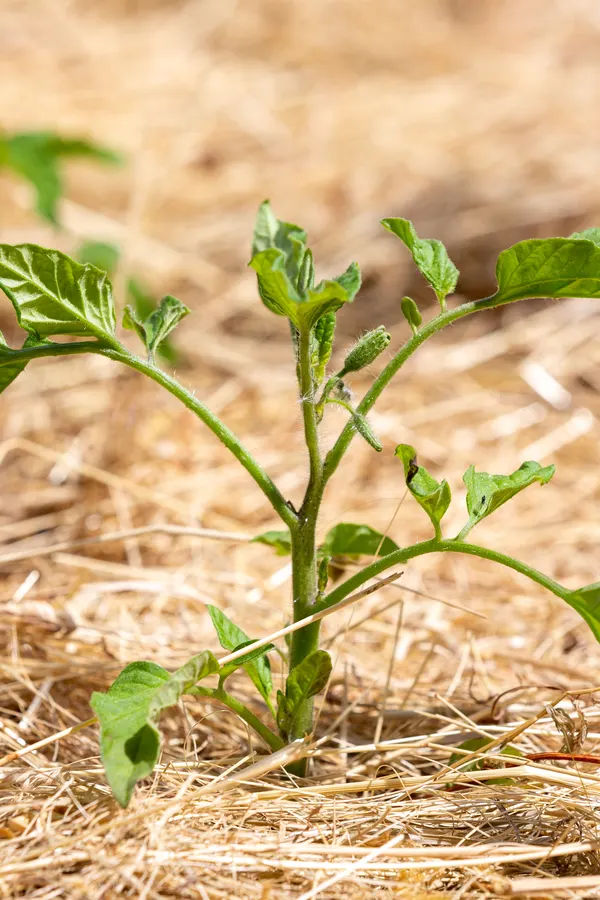Are your tomato leaves on your newly planted tomatoes turning yellow?
Yellowing leaves are one of the most common issues gardeners face when growing tomatoes. Especially in the early stages of growth. Tomato plants can struggle to take off after transplanting – and yellow leaves are often the first sign that something isn’t quite right.
While there can be a few different reasons for this, more times than not, the root of the problem comes down to one main issue – too much water.

Why Too Much Water Can Be Turning Your Tomato Leaves Yellow
Yellow leaves on a tomato plant can be confusing, especially for new gardeners. It’s easy to assume the yellowing is caused by the plant not getting enough water. After all, yellow leaves often look dry and sickly.
But in reality, the opposite is usually true. More often than not, it’s too much water that is to blame, not too little. Tomato plants, like all vegetables, need water to survive. But when they get too much of it, the roots begin to suffer.
The root system of a tomato plant is responsible for taking in oxygen and nutrients from the soil. When the soil around the roots stays too wet, the oxygen gets pushed out. Over time, this wet environment causes the roots to swell and become waterlogged.
When roots swell up like this, they can no longer take in nutrients effectively. The plant starts to suffer, and it shows up in the leaves. Instead of the bright, healthy green color tomato plants are known for, the leaves begin to turn pale, then yellow. This is the plant’s way of signaling that it’s not getting the nutrition it needs to grow.
The tricky part is that many gardeners see the yellow leaves and assume the plant is thirsty. So, they water more. And unfortunately, that only makes things worse. The soil stays soggy, the roots get more stressed, and the leaves continue to yellow. Eventually, the plant can even die if the issue isn’t corrected.

Why Young Plants Suffer Most
Young tomato plants are especially prone to their leaves turning yellow. Right after transplanting into the ground or a container, their roots are still getting adjusted to the new environment. If you add heavy watering on top of that, it’s easy to overwhelm them.
Because young plants don’t have deep roots yet, the moisture builds up in the top few inches of soil. That, of course, is right where their roots are trying to grow.
Early spring rains, cooler weather, and cloudy days can make it worse. With less sunshine and warmth, the soil doesn’t dry out as quickly. That can lead to soggy conditions that linger day after day, which is bad news for young tomatoes trying to settle in and grow strong.
How To Avoid Overwatering
The best way to avoid overwatering your tomato plants is to know exactly how wet the soil is before you water. That’s where a moisture meter can be a huge help. These small, inexpensive tools are easy to use. You simply push the probe into the soil, and it gives you a quick reading of how wet or dry the soil is. Affiliate Link: XLUX Long Probe Deep Use Soil Moisture Meter
Tomato plants do best when the soil is kept evenly moist but not soggy. You want the soil to be damp several inches down but not soaking wet. If the meter reads in the “wet” zone, you don’t need to water. If it shows “dry,” especially a few inches deep, then it’s time to give your plants a drink.

Many gardeners are surprised by how wet their soil actually is, even after a few days without rain. Using a moisture meter can take the guesswork out of watering and help prevent yellow leaves before they start.
How Much Water Do Tomato Plants Really Need?
So how much water is the right amount? For tomato plants in the ground, about 1 to 1.5 inches of water per week is all they really need. That can come from rain, hand watering, or a combination of both. If your area gets regular rainfall, you may not need to water much at all.
Instead of watering a little every day, it’s better to water deeply every few days. Deep watering encourages the roots to grow deeper into the soil. That helps plants find moisture during dry spells and makes the plant more stable and productive. Shallow, frequent watering keeps the roots near the surface, where the soil dries out faster.
If you’re growing tomatoes in containers, keep in mind that they’ll likely need to be watered more often than those in the ground. Containers dry out faster, especially in hot weather. But even so, it’s important to let the top inch or two of soil dry out before watering again.
If The Soil Is Soggy – Remove The Mulch
So what if your plants leaves are yellow right now? The first thing you can do (besides not watering) to help is remove any mulch.

Mulch is great for tomato plants. It helps keep moisture in the soil, regulates temperature, and keeps weeds down. But when your soil is already too wet, mulch can trap in even more moisture. That’s why, if your tomato plants are showing signs of overwatering and the soil feels soggy, you may need to temporarily remove the mulch around the base of the plant.
Removing the mulch allows air and sunlight to reach the soil, helping it dry out faster. Once the soil has returned to a normal moisture level, you can replace the mulch to help keep it that way. Just be sure to keep mulch a few inches away from the plant’s main stem. This will avoid trapping moisture right at the base, which can lead to rot.
Switch To A Granular Fertilizer To Stop Tomato Leaves From Turning Yellow
When tomato leaves turn yellow from overwatering, the plants are lacking nutrients. But adding a liquid fertilizer at this point will only make the problem worse. Applying more liquid to already soggy soil just adds to the stress.
Instead, switch to a dry, granular fertilizer. A slow-release granular fertilizer sits on the soil and gradually dissolves as you water or as it rains. It delivers nutrients without dumping more water into the soil. This can help feed the plant and encourage the roots to recover without worsening the wet conditions. Affiliate Link: 5-10-10 Tomato & Vegetable Granular Fertilizer
You can apply a light dose of fertilizer around the base of the plant, keeping it a few inches away from the stem. As the plant begins to recover, you should start to see new green leaves appearing, and the yellowing should slowly stop spreading. For more on fertilizing, see: How To Fertilize Tomato Plants In The Summer For A Bigger Harvest.

Don’t Panic – Tomato Plants Can Bounce Back
Yellow leaves are a warning sign, but they don’t always mean the plant is doomed. If caught early, many tomato plants can bounce back from overwatering with just a little care and patience. By cutting back on water, allowing the soil to dry out, and feeding your plants the right nutrients, you can turn things around quickly.
It’s also a good idea to remove the worst of the yellow leaves once the plant is recovering. This helps the plant focus its energy on producing new, healthy growth. Just be sure not to remove too many leaves at once.
Tomatoes need foliage to photosynthesize and grow, so it’s best to snip off a few of the most damaged leaves at a time over the course of a few days. Here’s to stopping your tomato leaves from turning yellow – and to a big harvest this summer of tomatoes! For more tips on keeping your tomato plants healthy, be sure to check out: How To Get Rid Of Aphids On Tomato Plants – Fast!
This Is My Garden
Follow Our Facebook Page For Great Gardening Tips And Advice! This Is My Garden Facebook Page
This Is My Garden is a garden website created by gardeners, for gardeners. Jim and Mary Competti have been writing gardening, DIY and recipe articles and books and speaking for over 15 years from their 46 acre Ohio farm. They publish three articles every week, 52 weeks a year. Sign up today to follow via email, or follow along!
